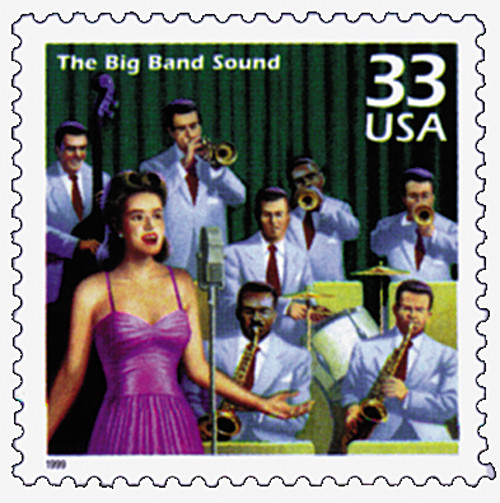
# 3186h - 1999 33c Celebrate the Century - 1940s: Abstract Expressionism
US #3186h
1999 Abstract Expressionism – Celebrate the Century (1940s)
• Part of the fifth sheet in the Celebrate the Century stamp series issued from 1998-2000
• Honors the abstract expressionism art movement
• Includes text on the back with historical details
Stamp Category: Commemorative
Series: Celebrate the Century
Value: 32¢ First Class Mail Rate
First Day of Issue: February 18, 1999
First Day City: Dobbins Air Force Base, Georgia
Quantity Issued: 188,000,000
Printed by: Ashton Potter (USA) Ltd.
Printing Method: Offset, Intaglio
Format: Panes of 15
Perforations: 11.5
Tagging: Block Tagging
Why the stamp was issued: To commemorate the abstract expressionism art movement and its impact on the future of the art world.
About the stamp design: Pictures a painting by Howard Koslow of Jackson Pollock working on a painting. Includes the following text on the back: “Abstract Expressionism was marked by a range of individual styles of modern painting and sculpture. Jackson Pollock (1912-1956) created his most famous gestural abstractions by pouring paint onto canvas laid on his studio floor.”
First Day City: The First Day of Issue Ceremony was held at the Dobbins Air Force Base Fuel Cell Hangar in Georgia.
About the Celebrate the Century series: The USPS launched the Celebrate the Century series in 1998 to mark the end of the 20th century and herald the arrival of the 21st. The series includes 10 sheets of 15 stamps (150 in total), with each honoring important moments from a different decade (1900s, 10s, 20s, 30s, 40s, 50s, 60s, 70s, 80s, and 90s). At the time of completion, it was the longest and most ambitious commemorative stamp series in US history.
History the stamp represents: The abstract expressionist movement in American painting is still considered one of the most significant in art history. Its emergence shifted the capital of the art world from Paris to New York City, for the first time earning world recognition for American artists’ modern creations.
Often called the New York School, artists of this movement rejected traditional methods and emphasized the expressive possibilities of color, line, and form. Members of this school included Willem de Kooning, Mark Rothko, Robert Motherwell, and David Smith.
Jackson Pollock (1912-1956) was arguably the group’s most famous member, and the first to achieve international fame during the post-World War II period. His working method was to place canvas on the floor of his studio and drip and splatter paint from above.
Pollock’s physical movements are credited with giving rise to the term action painting. He used hard brushes, sticks, trowels, and even glass syringes to create the abstract works for which he is best known. Jackson Pollock was the first artist since Norman Rockwell to be pictured on a stamp.
US #3186h
1999 Abstract Expressionism – Celebrate the Century (1940s)
• Part of the fifth sheet in the Celebrate the Century stamp series issued from 1998-2000
• Honors the abstract expressionism art movement
• Includes text on the back with historical details
Stamp Category: Commemorative
Series: Celebrate the Century
Value: 32¢ First Class Mail Rate
First Day of Issue: February 18, 1999
First Day City: Dobbins Air Force Base, Georgia
Quantity Issued: 188,000,000
Printed by: Ashton Potter (USA) Ltd.
Printing Method: Offset, Intaglio
Format: Panes of 15
Perforations: 11.5
Tagging: Block Tagging
Why the stamp was issued: To commemorate the abstract expressionism art movement and its impact on the future of the art world.
About the stamp design: Pictures a painting by Howard Koslow of Jackson Pollock working on a painting. Includes the following text on the back: “Abstract Expressionism was marked by a range of individual styles of modern painting and sculpture. Jackson Pollock (1912-1956) created his most famous gestural abstractions by pouring paint onto canvas laid on his studio floor.”
First Day City: The First Day of Issue Ceremony was held at the Dobbins Air Force Base Fuel Cell Hangar in Georgia.
About the Celebrate the Century series: The USPS launched the Celebrate the Century series in 1998 to mark the end of the 20th century and herald the arrival of the 21st. The series includes 10 sheets of 15 stamps (150 in total), with each honoring important moments from a different decade (1900s, 10s, 20s, 30s, 40s, 50s, 60s, 70s, 80s, and 90s). At the time of completion, it was the longest and most ambitious commemorative stamp series in US history.
History the stamp represents: The abstract expressionist movement in American painting is still considered one of the most significant in art history. Its emergence shifted the capital of the art world from Paris to New York City, for the first time earning world recognition for American artists’ modern creations.
Often called the New York School, artists of this movement rejected traditional methods and emphasized the expressive possibilities of color, line, and form. Members of this school included Willem de Kooning, Mark Rothko, Robert Motherwell, and David Smith.
Jackson Pollock (1912-1956) was arguably the group’s most famous member, and the first to achieve international fame during the post-World War II period. His working method was to place canvas on the floor of his studio and drip and splatter paint from above.
Pollock’s physical movements are credited with giving rise to the term action painting. He used hard brushes, sticks, trowels, and even glass syringes to create the abstract works for which he is best known. Jackson Pollock was the first artist since Norman Rockwell to be pictured on a stamp.














